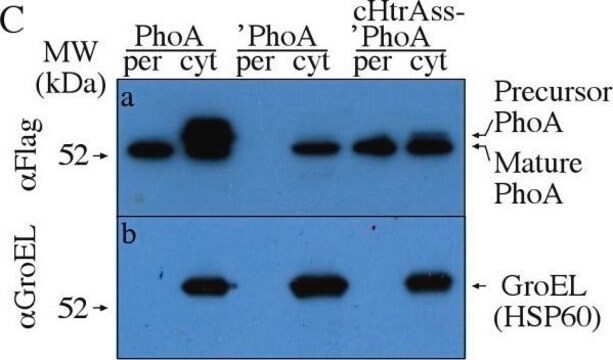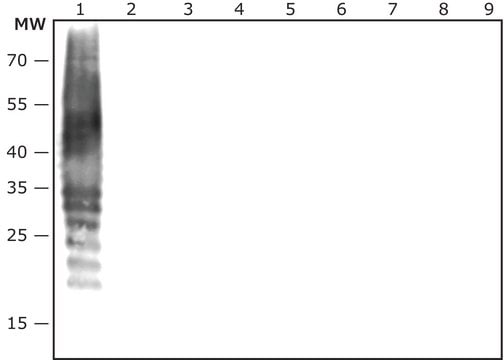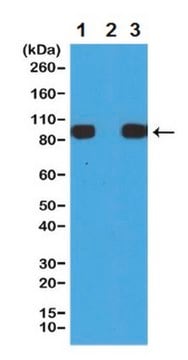OB05
Anti-Histidine-Tagged Protein Mouse mAb (13/45/31/2)
liquid, clone 13/45/31/2, Calbiochem®
Synonym(s):
Anti-His6
Sign Into View Organizational & Contract Pricing
All Photos(1)
About This Item
UNSPSC Code:
12352203
NACRES:
NA.41
Recommended Products
biological source
mouse
Quality Level
antibody form
purified antibody
antibody product type
primary antibodies
clone
13/45/31/2, monoclonal
form
liquid
contains
≤0.1% sodium azide as preservative
species reactivity (predicted by homology)
all
manufacturer/tradename
Calbiochem®
storage condition
do not freeze
isotype
IgG1
shipped in
wet ice
storage temp.
2-8°C
target post-translational modification
unmodified
General description
Anti-Histidine-Tagged Protein, mouse monoclonal, clone 13/45/31/2, specifically recognizes an epitage of 6 consecutive His residues. It is validated for use in ELISA, WB, IF & IP.
Purified mouse monoclonal antibody generated by immunizing mice with the specified immunogen and fusing splenocytes with Sp2/0 mouse myeloma cells. Recognizes a His•Tag sequence in native and recombinant proteins. Specifically recognizes an epitope of six consecutive His residues of both natural and recombinant sources.
Specifically recognizes an epitage of six consecutive His residues of both natural and recombinant sources.
Immunogen
Epitope: HHHHHH
a recombinant protein containing a His•Tag sequence
Application


ELISA (0.1-0.4 g/ml)
Immunoblotting (1-4 g/ml)
Immunofluorescence (1-4 g/ml)
Immunoprecipitation (4 g/ml)
Packaging
Please refer to vial label for lot-specific concentration.
Warning
Toxicity: Standard Handling (A)
Physical form
In 50 mM sodium phosphate buffer, 0.2% gelatin, pH 7.5.
Analysis Note
Positive Control
Proteins containing a His•Tag sequence
Proteins containing a His•Tag sequence
Other Notes
Antibody should be titrated for optimal results in individual systems.
Zentgraf, H., et al. 1995. Nucl. Acids. Res.23, 3347.
Gu, J., et al. 1994. BioTechniques17, 257.
Sporeno, E., et al. 1994. J. Biol. Chem., 10991.
Sisk, W.P., et al. 1994. J. Virol.68, 766.
Lu, T., et al. 1993. Anal. Biochem.213, 318.
Garner, J., et al. 1992. Cell69, 833.
Hochuli, E., et al. 1987. J. Chromatogr.411, 177.
Gu, J., et al. 1994. BioTechniques17, 257.
Sporeno, E., et al. 1994. J. Biol. Chem., 10991.
Sisk, W.P., et al. 1994. J. Virol.68, 766.
Lu, T., et al. 1993. Anal. Biochem.213, 318.
Garner, J., et al. 1992. Cell69, 833.
Hochuli, E., et al. 1987. J. Chromatogr.411, 177.
Legal Information
Manufactured by Dianova, GmbH, Germany.
CALBIOCHEM is a registered trademark of Merck KGaA, Darmstadt, Germany
Not finding the right product?
Try our Product Selector Tool.
Storage Class Code
11 - Combustible Solids
WGK
WGK 1
Flash Point(F)
Not applicable
Flash Point(C)
Not applicable
Certificates of Analysis (COA)
Search for Certificates of Analysis (COA) by entering the products Lot/Batch Number. Lot and Batch Numbers can be found on a product’s label following the words ‘Lot’ or ‘Batch’.
Already Own This Product?
Find documentation for the products that you have recently purchased in the Document Library.
Maureen C Dolan et al.
Methods in molecular biology (Clifton, N.J.), 824, 65-105 (2011-12-14)
Protein-specific antibodies serve as critical tools for detection, quantification, and characterization of recombinant proteins. Perhaps the most important and widely used antibody-based procedures for recombinant protein applications are Western immunoblotting and enzyme-linked immunosorbent assays (ELISAs). These analyses require well-characterized, sensitive
J Mario Isas et al.
Nature communications, 12(1), 4272-4272 (2021-07-15)
The first exon of the huntingtin protein (HTTex1) important in Huntington's disease (HD) can form cross-β fibrils of varying toxicity. We find that the difference between these fibrils is the degree of entanglement and dynamics of the C-terminal proline-rich domain
Jia Chen et al.
Journal of virology, 94(21) (2020-08-28)
Both Epstein-Barr virus (EBV) and Kaposi's sarcoma-associated herpesvirus (KSHV) are human gammaherpesviruses and are important in a variety of malignancies. Eph family receptor tyrosine kinase A2 (EphA2) is a cellular receptor for KSHV and EBV. Previous studies identified five conserved
Performance evaluation of antibody tests for detecting infant respiratory syncytial virus infection.
Samadhan J Jadhao et al.
Journal of medical virology, 93(6), 3439-3445 (2020-12-17)
Respiratory syncytial virus (RSV) infection is a major cause of respiratory tract disease in young children and throughout life. Infant infection is also associated with later respiratory morbidity including asthma. With a prospective birth cohort study of RSV and asthma
Larry J Anderson et al.
Frontiers in immunology, 14, 1332772-1332772 (2024-01-29)
Effective respiratory syncytial virus (RSV) vaccines have been developed and licensed for elderly adults and pregnant women but not yet for infants and young children. The RSV immune state of the young child, i.e., previously RSV infected or not, is
Our team of scientists has experience in all areas of research including Life Science, Material Science, Chemical Synthesis, Chromatography, Analytical and many others.
Contact Technical Service






